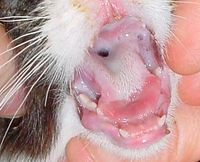Difference between revisions of "Feline Calicivirus"
m |
|||
| Line 41: | Line 41: | ||
Clinical signs are non specific with many other differentials. Nasal, conjunctival, or oropharyngeal swabs can be taken for virus isolation. Cytology of affected cells may demonstrate pyknosis (an irreversible condensation of chromatin in the cell nucleus undergoing necrosis or apoptosis) - feline herpes causes cellular swelling and syncytia formation. | Clinical signs are non specific with many other differentials. Nasal, conjunctival, or oropharyngeal swabs can be taken for virus isolation. Cytology of affected cells may demonstrate pyknosis (an irreversible condensation of chromatin in the cell nucleus undergoing necrosis or apoptosis) - feline herpes causes cellular swelling and syncytia formation. | ||
| − | + | ==Control== | |
*Virulent isolate outbreak: quarantine and restrict movement of in contact animals. | *Virulent isolate outbreak: quarantine and restrict movement of in contact animals. | ||
*Prevention: Live or dead [[Vaccines|vaccines]] are available that contain broadly cross-reactive strains. [[Vaccines#Cat_Vaccinations|Vaccination]] is often given in combination with feline herpes and panleukopenia virus immunization. | *Prevention: Live or dead [[Vaccines|vaccines]] are available that contain broadly cross-reactive strains. [[Vaccines#Cat_Vaccinations|Vaccination]] is often given in combination with feline herpes and panleukopenia virus immunization. | ||
Revision as of 08:15, 10 August 2011
| This article has been peer reviewed but is awaiting expert review. If you would like to help with this, please see more information about expert reviewing. |
Introduction
The normal hosts for this virus are domestic cats and cheetahs. The virus has a high morbidity/low mortality rate, but affected animals can be further compromised by concurrent infection. The incubation period is 2-10 days.
Clinical signs include:
- Vesicles and ulcers of the oral epithelium (2-5mm)
- Nasal and ocular discharge
- Sneezing
- Anorexia
Variable signs include:
- Pyrexia
- Dyspnoea
- Conjunctivitis
- Rhinitis
- Tracheitis
- Pneumonia
Differential Diagnoses may include:
- Feline Herpes
- Clamydophila felis
- Bordetella bronchiseptica
Recovery can be followed by carrier status
Epidemiology
FCV is endemic worldwide. Transmission occurs through direct contact with secretions of carrier cats or indirect contact via drinking bowls, etc. Clinical disease is most frequently seen in kittens; active immunity is generally present in animals over 1 year of age. Antigenic variation means that subclinical reinfections can occur.
Antigenicity
A single serotype has been identified which typically has antigenic variations.
Recent strains of the virus have been shown to cause systemic disease, where the initial upper respiratory signs are followed by:
- Severe pyrexia
- Oedema, particularly of the head and limbs
- Skin ulcers
- Icterus and Petchiae
The mortality rate of recently emerging strains can be as high as 50%, and higher in cats over 1 year of age. Conventional vaccinations are thought to be ineffective against these strains.
Diagnosis
Clinical signs are non specific with many other differentials. Nasal, conjunctival, or oropharyngeal swabs can be taken for virus isolation. Cytology of affected cells may demonstrate pyknosis (an irreversible condensation of chromatin in the cell nucleus undergoing necrosis or apoptosis) - feline herpes causes cellular swelling and syncytia formation.
Control
- Virulent isolate outbreak: quarantine and restrict movement of in contact animals.
- Prevention: Live or dead vaccines are available that contain broadly cross-reactive strains. Vaccination is often given in combination with feline herpes and panleukopenia virus immunization.
The virus presents a particular concern for catteries due to the epidemiological risk of spread in intensively kept cats.
Links
Literature Search
Use these links to find recent scientific publications via CAB Abstracts (log in required unless accessing from a subscribing organisation).
Feline Calicivirus publications

